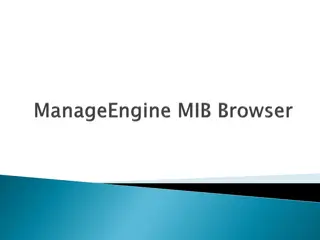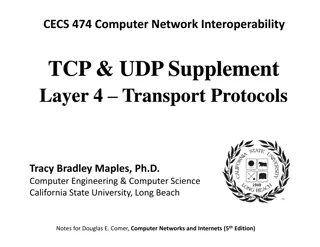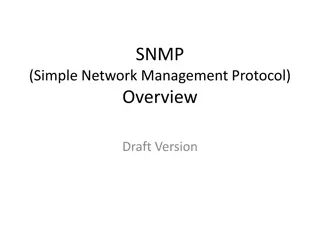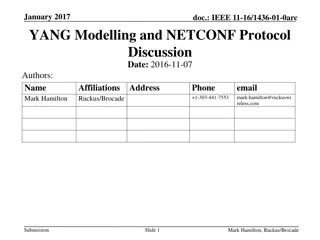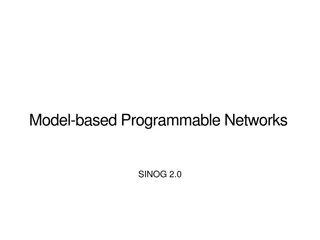
Simple Network Management Protocol (SNMP)
Learn about SNMP, a crucial networking protocol used for managing and monitoring network-connected devices in Internet Protocol networks. Explore its features, implementations, versions, and more.
Download Presentation

Please find below an Image/Link to download the presentation.
The content on the website is provided AS IS for your information and personal use only. It may not be sold, licensed, or shared on other websites without obtaining consent from the author. If you encounter any issues during the download, it is possible that the publisher has removed the file from their server.
You are allowed to download the files provided on this website for personal or commercial use, subject to the condition that they are used lawfully. All files are the property of their respective owners.
The content on the website is provided AS IS for your information and personal use only. It may not be sold, licensed, or shared on other websites without obtaining consent from the author.
E N D
Presentation Transcript
Contents What is SNMP? Where is SNMP? SNMP and UDP SNMP Management Information Bases (MIBs) Versions of SNMP SNMP Runtime Components SNMP and Network Size SNMP Commands What is an SNMP port? Limitations of SNMP Management
What is SNMP? Simple Network Management Protocol (SNMP) is a networking protocol used for the management and monitoring of network- connected devices in Internet Protocol networks.
Where is SNMP The SNMP protocol is embedded in multiple local devices such as: routers, switches, servers, firewalls, and wireless access points accessible using their IP address.
Where is SNMP SNMP provides a common mechanism for network devices to relay management information within single and multi-vendor LAN or WAN environments. It is an application layer protocol in the OSI model framework.
SNMP and UDP Typically, the SNMP protocol is implemented using the User Datagram Protocol (UDP). UDP is a connectionless protocol that works like the Transmission Control Protocol (TCP) but assumes that error-checking and recovery services are not required. Instead, UDP continuously sends datagrams to the recipient whether they receive them or not.
SNMP Management Information Bases (MIBs) Data structures that define what can be collected from the local device and what can be changed and configured. There are many MIBs defined by standards bodies such as the IETF and ISO, as well as proprietary MIBs defined by specific IT equipment vendors such as Cisco and software vendors such as Microsoft and Oracle.
Versions of SNMP There are three different versions of SNMP: SNMP version 1 (SNMPv1) This was the first implementation, operating within the structure management information specification, and described in RFC 1157. SNMP version 2 (SNMPv2) This version was improved to support more efficient error handling and is described in RFC 1901. It was first introduced as RFC 1441. It is often referred to as SNMPv2c. SNMP version 3 (SNMPv3) This version improves security and privacy. It was introduced in RFC 3410.
SNMP Runtime Components These are the main runtime components in an SNMP-enabled environment: SNMP-managed devices and resources These are the devices and network elements on which an agent runs. SNMP agent This software runs on the hardware or service being monitored by SNMP, collecting data on various metrics like CPU usage, bandwidth usage or disk space. As queried by the SNMP manager, the agent finds and sends this information back to SNMP management systems. SNMP manager (also referred to as SNMP server) This component functions as a centralized management station running an SNMP management application on many different operating system environments. It actively requests agents send SNMP updates at regular intervals.
Management information base (MIB) Management information base (MIB) This data structure is a text file (with a .mib file extension) that describes all data objects used by a particular device that can be queried or controlled using SNMP including access control. Inside the MIB there are many different managed objects which can be identified by Object Identifiers. An Object Identifier (OID) is a MIB identifier that is used to delineate between devices within the MIB. OIDs are uniquely generated as numeric identifiers used for access to MIB objects.
SNMP and Network Size While SNMP is used in a network of any size, its biggest value is when used in larger networks. By using SNMP, a network administrator will be able to manage and monitor all SNMP devices from a single interface.
SNMP SNMP Commands Commands SNMP tools perform many functions that rely on a mix of push and pull communications between network devices and the network management system. At its core set of functions, it can execute read or write commands, such as resetting a password or changing a configuration setting. It can also find how much network bandwidth, CPU and memory are in use. Some SNMP managers can automatically send the administrator an email or text message alert if a predefined threshold is exceeded.
SNMP Commands SNMP Commands Get Request A request to retrieve the value of a variable or list of variables. Set Request Sent by the SNMP manager to the agent to issue configurations or commands. GetNext Request Sent by the SNMP manager to agent to find the values of the next record in the MIB's hierarchy. GetBulk Request Sent by the SNMP manager to the agent to obtain large tables of data by performing multiple GetNext Request commands. SNMP Response Sent by the agent to the SNMP manager, issued in reply to a SNMP Trap Asynchronous trap messages from SNMP agents alert an SNMP manager that a significant event such as an error or failure, has occurred. SNMP Inform Confirms receipt of a trap.
What is an SNMP port What is an SNMP port? ? SNMP ports are utilized via: UDP 161 for SNMP Managers communicating with SNMP Agents (i.e. polling) and UDP 162 when agents send unsolicited Traps to the SNMP Manager.
Limitations of SNMP Limitations of SNMP Management Management One of the chief limitations of SNMP network management comes from its focus on device-specific metrics. While these are essential to understanding device status, they are siloed from other infrastructure data sets such as traffic flow records. In addition, SNMP monitoring doesn't provide any insight into user experience or digital experience.


